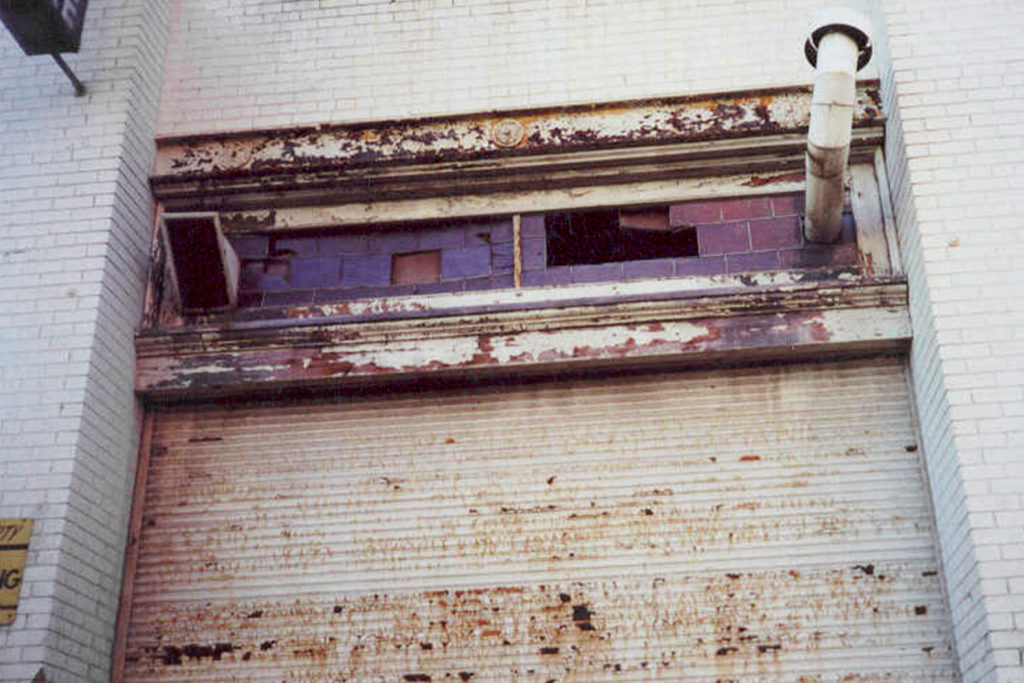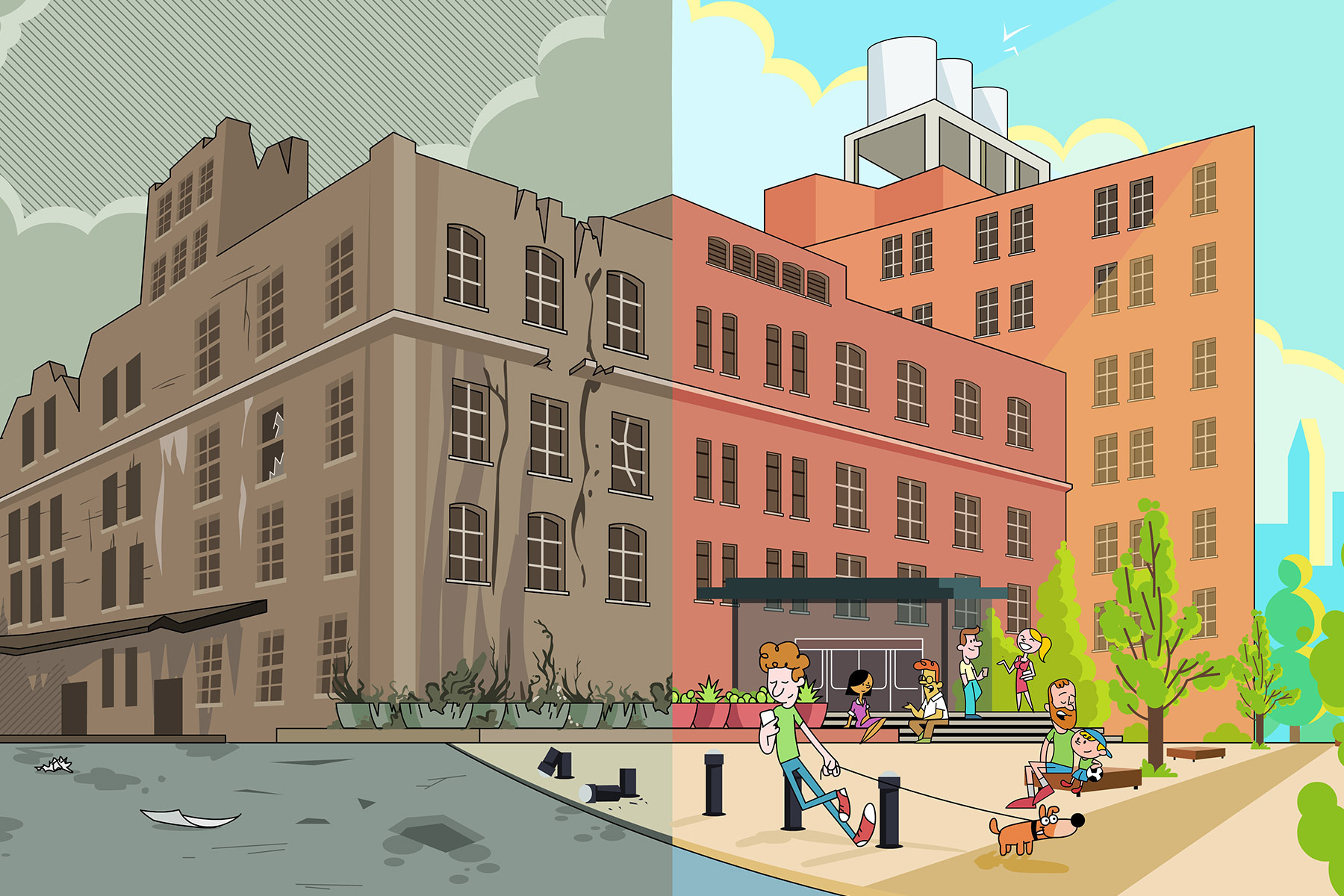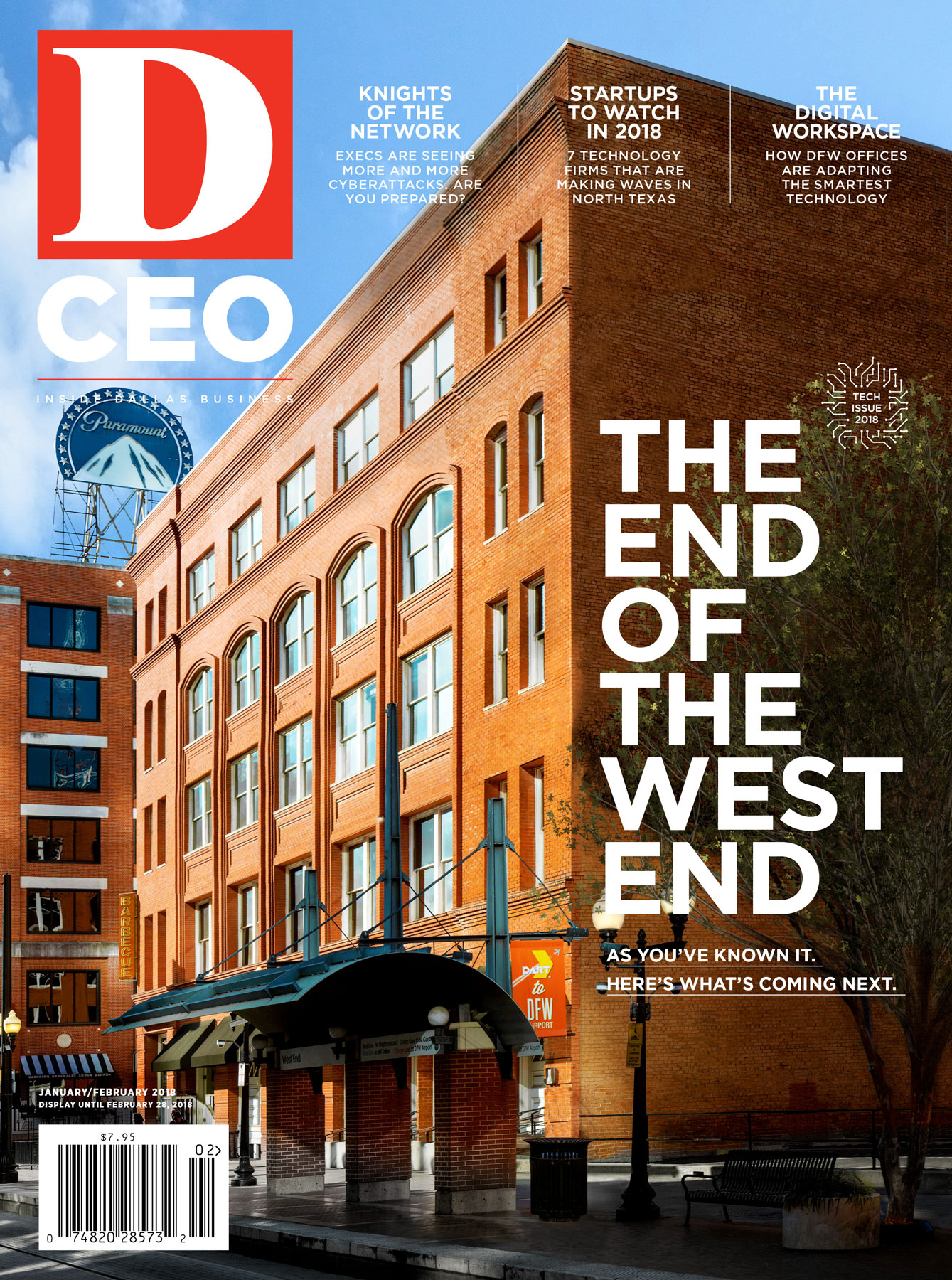 July 2015, the West End Marketplace—a former cracker and candy factory turned shopping mall and movie theater turned eyesore in Dallas’ West End Historic District—had sat empty for a decade. When the property came up for sale, it caught interest from local investors who came out to kick the tires. But it was a tough sell. The property had great bones, sat in one of Dallas’ few truly walkable neighborhoods, and had a compelling history. But historic renovations like West End Marketplace present a lot of unknowns. To make the deal pencil, the new owner would need to get cozy with the city and historical organizations to capitalize on tax credits and incentives.
July 2015, the West End Marketplace—a former cracker and candy factory turned shopping mall and movie theater turned eyesore in Dallas’ West End Historic District—had sat empty for a decade. When the property came up for sale, it caught interest from local investors who came out to kick the tires. But it was a tough sell. The property had great bones, sat in one of Dallas’ few truly walkable neighborhoods, and had a compelling history. But historic renovations like West End Marketplace present a lot of unknowns. To make the deal pencil, the new owner would need to get cozy with the city and historical organizations to capitalize on tax credits and incentives.Then Granite Properties, a developer that was better known locally for its suburban office parks—such as Plano’s Granite Park and Addison’s Spectrum Center—purchased the property from ECOM Real Estate Management. And, within the next 18 months, most of the West End’s office properties also would trade hands, going from family-style ownership to institutional landlords who promised renovations, better property management—and steeper rents. “Every developer in town was looking for the next infill location,” Granite Properties CIO Bill Brown says. “If West End was ever going to be turned around, now was its time.”
For the last 120 years, the West End has been scarred by a number of people who underestimate the district, and helped by handfuls who see opportunity. As former owners like ECOM and Owen Hannay’s Five Smooth Stones began selling their properties, institutional landlords like Granite, Crescent Real Estate, Lincoln Property Co., and Spear Street Capital stepped forward. And now, as the first wave of the new ownership’s renovations come to fruition and new developments break ground, the next chapter of the storied district is unfolding. But not everyone is thrilled with the results.
Renewed Purpose
In the recent past, the West End had been a mix of mom-and-pop-style landlords who charged modest rents and kept buildings reasonably full, and neglected properties that sat in some form of transition or disrepair.
When Granite entered the neighborhood, the West End—roughly bounded by Woodall Rodgers, Interstate 35, Lamar Street, and Jackson Street—wasn’t solely untapped potential, of course. Much of it had already been realized. Owners like Five Smooth Stones, longtime restaurants like The Palm, and newer innovators like the Dallas Entrepreneur Center had already become cheerleaders for one of the oldest districts in Dallas. Such stakeholders, primarily through the neighborhood advocacy group called the West End Association, were improving the neighborhood. But when Granite purchased the West End Marketplace with plans to redevelop it into an old-meets-new office space dubbed Factory Six03, the ears of every major landlord in town pricked up.
A few months later, in late 2015, Spear Street Capital, a national landlord known for owning and operating tech-related real estate, purchased Landmark Center at 1801 Lamar St.
Around the same time, Crescent and private equity firm Long Wharf Real Estate Partners snapped up Five Smooth Stones’ West End portfolio—which included 208 Market St., 800 Jackson St., 501 Elm St., 211 Record St., and two parking lots—in an off-market deal. More recently, Crescent bought 401 Houston St. and the adjacent parcel of land, on which it will construct an expansion of Corgan’s architecture firm and about 80,000 square feet of speculative office space in its new building called The Luminary. In December 2016, ECOM sold Market-Ross Place, the 1905-era three-building complex, to yet another well-known owner, Lincoln Property Co.
Each landlord claimed nearly identical reasons for buying. The neighborhood’s brick-and-timber real estate is arguably the most unique in the city, they knew. Every DART rail line runs through the West End Station. The walkable neighborhood has over a century of history. Adjoining neighborhoods, such as Victory Park and the Arts District, were going through renaissances of their own. The Dallas Holocaust Museum, the Sixth Floor Museum, and the Kay Bailey Hutchison Convention Center keep a steady flow of tourists—over 7 million annually—coming to the West End.

But these landlords also saw a good business opportunity. “The previous owners were not putting a lot of capital into their buildings, not giving much [tenant improvements], and therefore weren’t pushing rates,” Granite COO and president Greg Fuller says. “We will put all the capital we need to into this building, and I think the Crescents and Lincolns saw that and felt they could do the same.”
Several of the new landlords who owned similar spaces in different cities knew creative-type tenants would pay a premium to office in such cool spaces. New owners could increase rents, after various upgrades to the building and improved property management, and still keep rates at a discount to Uptown. As a result, the exodus of previous landlords also meant the exit of many tenants unable or unwilling to pay higher rents.
Highs and Lows
Throughout the West End’s 120-year history, the neighborhood has slipped in and out of prominence, seeming to often take two steps forward and one step back.
In the early 1900s, the neighborhood became a thriving manufacturing hub, serving as a crown jewel for Dallas’ budding economy. On a November afternoon in 1963, President John F. Kennedy took some of his last breaths in the West End’s Dealey Plaza before being shot and rushed to Parkland Memorial Hospital. The country’s mourning, however, brought a subsequent boost in tourism as people flocked to the Sixth Floor Museum and surrounding area. As tourism surged, many warehouses fell into disarray.
In 1975, the Dallas City Council, “concerned with the gradual decline and decay of the area,” unanimously approved plans to create the West End Historic District. Over the next decade, investors started staking claim on the neighborhood. Entertainment tenants like Planet Hollywood brought locals back to the West End, making it something of a tourist haven by day and a local watering hole by night. But by the end of the 1980s, many of the area’s most notorious bars and restaurants—like the drug-fueled Starck Club—had closed up shop. Around the same time, rowdy club goers, in part, caused the neighborhood to become known as unsafe, a label the West End Association has been trying to reconcile.
“If the West End was ever going to be turned around, now was its time.”
Bill Brown, Granite Properties
The FBI moved into Landmark Center on Lamar Street in 1980, making it one of the largest tenants in the neighborhood, with more than 130,000 square feet. But after the Oklahoma City bombing and 9/11, the agency moved into a more secluded division headquarters, citing “rigorous security standards needed for the 21st century.”
Ellen’s Southern Kitchen opened a 55-seat restaurant in 2012, and quickly reached capacity. By 2016, owner Joe Groves opened a bigger restaurant just across the street from Ellen’s original concept. A year later, and with only a month’s notice to longtime customers, The Palm, a 33-year restaurant veteran of the West End, closed its doors, citing safety concerns. When pressed, The Palm declined to disclose specific safety incidences, frustrating neighbors trying to combat the West End’s reputation as a dangerous spot, which had been caused in part by the number of homeless and panhandlers in the area.
In June 2016, Trey Bowles’ and Jennifer Sanders’ Dallas Innovation Alliance unveiled plans to create a “smart city living lab” within the West End, generating buzz from movers and shakers in the innovation space. Days later, the world watched in horror as the Dallas police shootings ended in a gun battle at the West End’s El Centro College, where the shooter was finally killed by a robot-delivered bomb.
Days apart from each other in fall 2017, Crescent’s The Luminary, and the Dallas Holocaust and Human Rights Museum, broke ground on new buildings. Further marking the West End’s upswing, Dallas residents voted yes in November to a $1.05 billion bond, effectively paving (or un-paving, as it were) the way for a park to be created in place of the parking lot between Market-Ross and Spaghetti Warehouse.
Realities of Progress
When Crescent bought 208 N. Market St., one of the larger buildings in its West End portfolio at 62,000 square feet, the rents were $17 per square foot, plus electric costs. Now, rents there range from $17 to $21 per square foot triple net, according to CoStar. (In triple net leases, a landlord’s property taxes, insurance, and maintenance are passed on to tenants.)
“We always thought rents were artificially low there, because owners were not investing in those buildings. But now that people are, you will see a significant increase in rent,” Granite’s Fuller says. “But there’s a significant increase in cost too, so it’s not like you’re making a killing.”
Artificially low or not, pushing up rents was not a priority of previous-generation West End owners like Hannay. “My primarily objective was to keep [the buildings] full,” Hannay says. “The new buyers believe they can move rents pretty significantly. They’ve got deeper pockets and can take time to get the best rate … I hope they get their asking price.”

But that increase in cost varies widely by property. Granite took an empty building in disrepair, spent $77 million flipping it, and has been quoting leases at $35 per square foot, with a $8.26 Common Area Maintenance (CAM) expense that makes it the most expensive in the neighborhood—and a rival to some Uptown buildings. Other properties, such as 501 Elm St. and Landmark Center, were decently updated and occupied when they traded.
Several tenants have already exited the neighborhood, mainly blaming rising rents for their exodus. And Crescent Vice President Stephen Luik and Lincoln Property Executive Vice President Matt Craft agree that tenants will continue to leave, as more and more leases come up for renewal.
“[Previous to Crescent’s ownership,] you weren’t getting premium rents,” Luik says. “We noticed that issue, and thought we could come in and re-tenant the buildings. We did that with the understanding that we were going to lose customers, but we would backfill it.”
Co-working concept The Grove was one such tenant that moved out of the neighborhood after Crescent bought its building. Justin Nygren and Ken Janke opened The Grove in one of Hannay’s buildings in 2013. Like many landlords, Nygren saw the value in the neighborhood. “The West End is where the city started,” he says. “It has a pioneering and innovative spirit. We felt like we had an opportunity to tap back into that with The Grove.”
The Grove entered the neighborhood under Hannay’s objective to keep his buildings full, but closed up shop in August 2017, after Crescent bought the building. When The Grove closed after failing to come to a rental agreement with Crescent, Nygren said there was a spirit of frustration in the neighborhood, with a handful of tenants who had exited or planned to exit the West End because of rapidly rising rents.
Part of Crescent’s higher rents are due to expensive building systems that were updated, with the likes of new roofs and fire life systems, and on-site management and security, Luik says.
Lincoln is in a similar situation. “We don’t want to lose any [tenants], but people have to make financial decisions,” Craft says.
Lincoln has nearly doubled rents, according to CoStar, without yet starting several million dollars in planned renovations on the three-building office complex with ground-floor retail known as Market-Ross.
Regardless of owner, the West End struggled to maintain its approximate threshold of 170 tenants in 2016 and 2017. “Net absorption in the West End office market was basically zero in 2016 and is positive by 60,000 square feet so far” in 2017, as of mid-November, CoStar Senior Market Analyst David Kahn says. “Retail net absorption was around 10,000 square feet in 2016, but negligible in 2017.”
Rising Tide
As for reconciling the two perspectives—a business owner whose rent has just doubled, and a landlord who sees a business opportunity—Lincoln’s Craft says that is commonplace in an evolving submarket. He compares the office gentrification in the West End to Uptown a few years ago: “Some tenants paid, and others went up Central Expressway. That helped Central. I think it can be positive.”
From a business perspective, that’s true. As tenants leave the West End, the rest of downtown, the Cedars, and the Design District benefit.
And, that “rising tide lifts all boats” mentality is one the West End Association appreciates. As apartments bring in more residents, restaurants get more customers. As offices tighten up on security, the whole neighborhood gets safer. As Victory Park becomes a hot destination, that vivacity spills over Woodall Rogers.
“We don’t want to lose any [tenants], but people have to make financial decisions.”
Matt Craft, Lincoln Property Co.
But Crescent’s Luik, who is also president of the West End Association, admits the perception of the West End is lagging reality. “There’s still this perception that it’s not a vibrant district,” he says. “But if you talk to retailers, they’ll tell you their sales are as strong as they’ve [ever] been …”
It takes work to change perceptions, though. And the West End Association is doing the work. Luik details four distinct goals for his tenure as president of the WEA: Increase security, create and refine programming and events, better market the neighborhood, and light Market Street (to be reminiscent of Highland Park Village’s wrapped trees). The association has committees for each objective, and says it’s making progress on all four.
At Factory Six03, Granite scored a big win when Blue Cross Blue Shield of Texas leased about 30,000 square feet for its C1 Innovation lab. But leasing has otherwise been a little sluggish, because it’s tough to sell tenants on a space when it’s still under construction. “It has been such a war zone that it’s difficult to show the space and have people get it,” Granite’s Fuller says. That logic could be applied to the whole neighborhood: it’s hard to say just how much better the area has become until stakeholders have a little hindsight.
“I do see a renewed sense of purpose for the West End,” Fuller says. “But the proof will be when more occupants are down there.”






